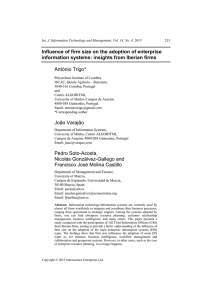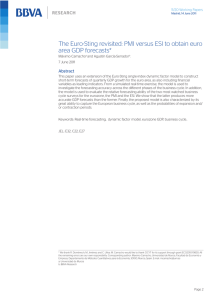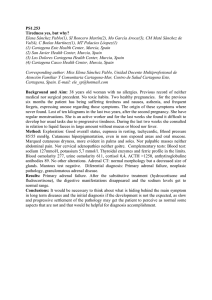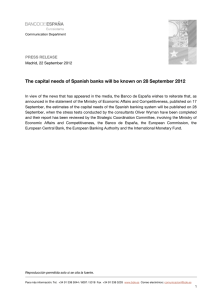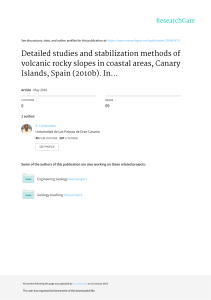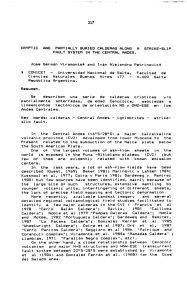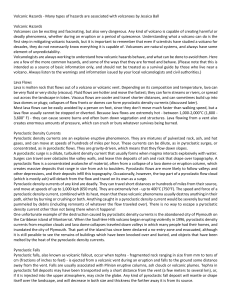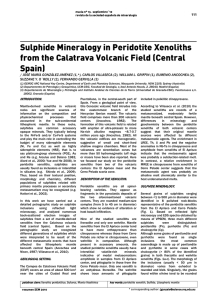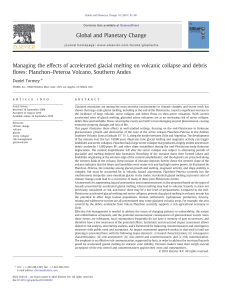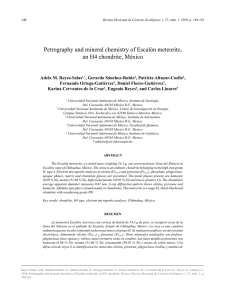neogene ultrapotassic volcanism
Anuncio
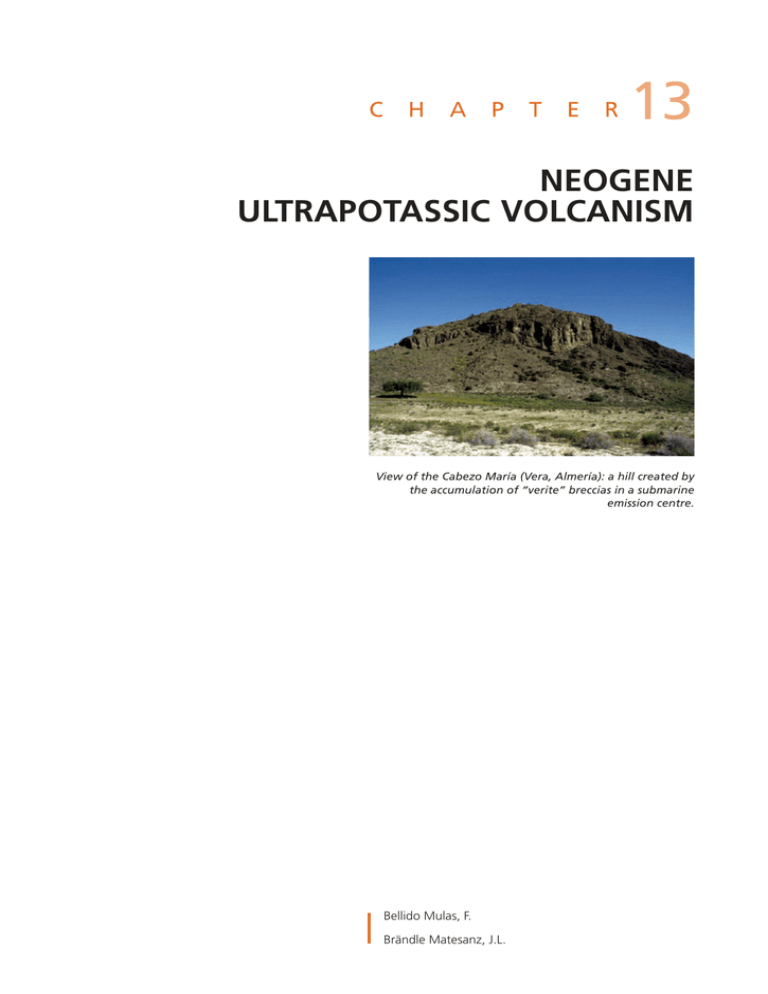
C H A P T E R 13 NEOGENE ULTRAPOTASSIC VOLCANISM View of the Cabezo María (Vera, Almería): a hill created by the accumulation of “verite” breccias in a submarine emission centre. Bellido Mulas, F. Brändle Matesanz, J.L. Figure 1, above. Location of the geosite’s outcrops. Figure 2, below. Jumillite of La Celia at the entrance to a gallery of the old apatite mines. Figure 3, below. Thin section photograph of a massive jumillite with conspicuous phenocrysts of olivine and phlogopite (magnified 33 times, parallel nichols). This chapter deals about the origin and significance of a small group of rocks resulting from a type of volcanism with very few representatives globally: ultrapotassic (lamproitic) volcanism. Their geodynamical and volcanological importance lies on the fact that their knowledge is paramount to study magmas coming from the Earth’s mantle. One of the most representative zones globally is found in the southeast of the Iberian Peninsula, in an area between Vera, the region of Cartagena, and the towns of Cancarix and Jumilla in the External Betic Domain (Figure 1). The examples chosen correspond to the type outcrops from which the rocks earned their generic name (verite, jumillite, fortunite, and cancalites or cancarixites), with photographs of the most representative samples as they are seen in the petrographic microscope. Also, in the volcanic area of Campos de Calatrava is the ultrapotassic emission centre of Morrón de Villamayor, among other Neogene volcanic edifices of ultra-alkaline character. Due to the diversity and complexity of the mineralogy of these rocks, they were given their own names, as they were considered to be different from other known rocks. The names verite, jumillite, fortunite and cancalite or cancarixite are all derived from the most important town near each exposure (Parga Pondal, 1935; Fuster et al., 1967). Within this volcanic province, it is possible to identify five magmatic associations: calcalkaline series, highpotassium calcalkaline series, shoshonitic series, ultrapotassic (lamproitic) series, and basaltic alkaline series. The volcanic events to which the first four series are linked took place between 15 and 6 million years ago, although the ultrapotassic volcanic activity is restricted to the final stages (8-6 million years ago). This volcanic province is related to the extensional event explained in the previous chapter, which took place between the middle and late Miocene (12 million years ago). During this extensional collapse, the volcanic events hereby considered occurred following the recently formed faults. The exceptional characteristics of the geodynamic context and volcanic features of this region have to be remarked, since they are not contemporary to the subduction processes. Instead, they are associated to the melting due to the extensional stage affecting the lithospheric mantle during the Miocene, which had previously been geochemically enriched in the subduction compressive phase, and also by contamination from other basement melts. Data recently obtained about the interpretation of this volcanism and its placement within the Betic orogen evolution can 14 0 Bellido Mulas, F. - Brändle Matesanz, J.L. Figure 4. Flow dome of Cancarix, formed by massive cancarixite or cancalite with columnar jointing, making up the main reliefs of Sierra de Las Cabras. Figure 5. Thin section photograph of a cancarixite with olivine, chestnut-coloured phlogopite, yellowish richterite, and sanidine (magnified 33 times, parallel nichols). be found in the works by López Ruiz et al. (2002, 2004) and Duggen et al. (2005). These volcanic deposits are mostly associated to volcanic chimneys, domes and dykes. Some of these edifices (Vera and Barqueros) preserve remains from the emission centers and flows. In the case of Vera, the main emission centre and the flows formed under shallow water. The ultrapotassic volcanic exposure from Jumilla, where jumillite was first described, is found in a place called La Mina – Caserío de La Celia (Figure 2) in Jumilla (Murcia). The rock shows a massive character, is brown-grey or dark green in colour, and displays an intense surface weathering. Their main mineralogy (Figure 3) consists of olivine phenocrysts, phlogopite and diopside, with apatite being relatively abundant. ULTRAPOTASSIC NEOGENE VOLCANISM In association with the scoria we find uneven concentrations of apatite and hematite (Celia Mines) which are linked to exhalative processes related to the volcanic activity, and which were developed in the past to be used in the fabrication of phosphate fertilizers. According to the absolute dating carried out by Duggen et al. (2005), the age of this volcanic edifice is 6.76 ± 0.04 million years. The exposure of Sierra de Las Cabras, between the villages of Cancarix and Agramón (Hellín, Albacete), is the type locality for cancalite or cancarixite. It consists of a volcanic dome with marked escarpments standing out over the plains, associated to Jurassic and Tertiary sedimentary exposures upon which it is found. The escarpments are formed by lavas with beautiful columnar jointing, rather homogeneous and with a 141 Figure 6, above. Submarine breccias of the Cabezo de María (Vera, Almería). Notice the vertical structures corresponding to dykes, and degassing channels of the emission centre. Figure 7. Thin section photograph of a verite (magnified 22 times, parallel nichols) with a vacuole filled by calcite, carbonated olivines, and pyroxene microliths in beige-greenish glass matrix (Cabezo María, Vera). grey colour with pink shades (Figure 4). Absolute datings provide an age of 7.04 ± 0.01 million years. These rocks have a main mineralogy formed by olivine, phlogopite, sanidine and potassic richterite. The most common accessory minerals are the apatite and calcite (Figure 5). The main exposures of verite are found in an area between the towns of Vera, Garrucha, Los Gallardos and Antas, near the Mediterranean coast, in the province of Almería. Here, the remains of an emission centre are located at Cabezo María (Figure 6), as well as several traces of lava flows scattered between this volcanic centre and the coast north of Garrucha. This emission centre is highly degraded and constitutes a promontory formed by tuffs, remains of lava 14 2 flows, submarine hydroclastic breccias, and dykes corresponding to feeder channels. Generally, these rocks have an abundant vitreous matrix and present olivine and phlogopite phenocrysts (Figure 7). Their radiometric age is 7.45 ± 0.08 million years. In La Salaosa and Cañada de las Moreras (Vera) there are outcrops of submarine lava flows of rather vitreous massive verite (Figure 8) which flowed on a bottom of Miocene marly sediments, scarcely or not even consolidated at all, which sometimes were injected in the flows to form so-called neptunian dykes. The flows are interbedded within Upper Miocene-Pliocene sandstones and marine marls. Fortunite (Figure 9) was described for the first time in the volcanic edifice of Los Cabecitos Negros de Fortuna (Murcia). It is a volcanic lamproitic rock Bellido Mulas, F. - Brändle Matesanz, J.L. Figure 8, above. Light-coloured marly sediments injected between the black pillow lavas of verite, typical of submarine lava flows. Figure 9, above, right. Outcrop of a circular dyke of fortunite injected in non-consolidated marly sediments. The dyke dips towards the interior of the volcanic edifice. Figure 10, right. Thin section photograph of a fortunite (magnified 13.5 times, parallel nichols): olivine and phlogopite phenocrysts in a chestnutcoloured glass matrix. Fortuna (Murcia). Figure 11, below. Conspicuous relief of lamproitic (ultrapotassic) lava flows lying on Miocene limestones and marls at the summit of the Cerro de Salmerón (Moratalla, Murcia). whose main mineral composition is orthopyroxene, phlogopite, sanidine and some diopside (Figure 10). The volcanic edifice of Cerro de Salmerón (Figure 11) or El Monagrillo (Moratalla, Murcia) is one of the most typical exposures of ultrapotassic volcanism in SE of Spain. It includes several units of a volcanic neck (roots of the point of emission), lava flows, dykes and breccias associated to its volcanic activity. The datings show an age of 7.12 ± 0.07 million years. The main mineralogy consists of olivine, phlogopite, amphibole and sanidine (Figure 12), with abundant apatite. The volcanic edifice of El Cabezo Negro de Zeneta (Murcia) is around 3 km southeast of Zeneta (Murcia), on a lonely hill standing out in mid Tortonian (Miocene) ULTRAPOTASSIC NEOGENE VOLCANISM sediments. Its morphology is that of a volcanic neck dome (Figure 13) intruded in Tortonian marls and sandstones, and has a breccioid chimney in its centre. The intrusion’s age is 8.08 ± 0.03 million years (postmid Tortonian). These are dark ultrapotassic rocks with a porphiritic texture and phenocrysts of phlogopite, biotite and olivine. Finally, the volcanic edifice of Calasparra (Murcia) can be seen at an old quarry near the junction of the road C-3314, 1.5 km to the northwest of Calasparra. It belongs to a small subaerial emission centre whose crater has a volcanic neck with columnar jointing (Figure 14). This geosite presents a magnificent exposure of ultrapotassic volcanic rocks and their 143 Figure 12. Thin section photograph of the ultrapotassic vulcanite of Cerro de Salmerón (Moratalla) with olivine phenocryst and phlogopite crystals in a sanidine and clinopyroxene matrix (magnified 13.5 times, crossed nichols). Figure 13. Morphology of the eastern end of the volcanic dome of Cabezo Negro de Zeneta (Murcia). Figure 14. Columnar jointing in lamproites of the central dome of the Cerro Negro volcano, Calasparra (Murcia). Figure 15. Thin section photograph of ultrapotassic lamproite from Calasparra: olivine phenocrysts and phlogopite in a microcrystalline matrix (magnified 52 times and parallel nichols). relations to the host sedimentary rocks of Tortonian age (Miocene). It displays a certain affinity to the jumillite, being its main mineralogical composition olivine, clinopyroxene, phlogopite, sanidine and alkali amphibole (Figure 15). It is therefore possible to conclude that, thanks to its global geodynamic, volcanologic and petrologic interest, it is highly important to study, popularize and protect these rocks, whose names are still used and quoted in international scientific media. The extreme rareness of these rocks in the international volcanological record is the reason to promote their protection, as it has already been done by the regional governments of Castilla-La Mancha and Murcia in the case of the Natural Monuments of the Volcanic Neck of Cancarix and Celia Mines. 14 4 Bellido Mulas, F. - Brändle Matesanz, J.L. REFERENCES BAENA, J. (1981). Mapa Geológico de España a escala 1/50.000 Nº 869 (Jumilla). IGME, Serv. Pub. Ministerio de Industria, Madrid. BELLIDO MULAS, F. and BRÄNDLE MATESANZ, J.L. (2006). Asociaciones volcánicas ultrapotásicas (lamproíticas) neógenas del SE de la Península Ibérica. Informe final para el "Proyecto Global Geosites", IGME. BELLON, H., BIZON, G., CALVO, J.P., ELÍZAGA, E., GAUDANT, J. and LÓPEZ MARTÍNEZ, N. (1981). Le volcan du Cerro del Monagrillo (Province de Murcia): âge radiométrique et corrélations avec les sédiments néogènes du bassin de Hellín (Espagne). Comptes Rendus Academie Sciences de Paris, 292, 1.035-1.038. DUGGEN, S., HOERNLE, K., Van den BOGAARD, P. and GARBE-SCHÖNBERG, D. (2005). Post-collisional transition from subduction to intraplate-type magmatism in the westernmost Mediterranean: Evidence for continentaledge delamination of subcontinental lithosphere. Journal of Petrology, 46, 1.155-1.201. FERMOSO, M.L. (1967). El diópsido de las rocas volcánicas de Jumilla (SE de España). Estudios Geológicos, 23, 31-33. FERNÁNDEZ SANTÍN, S. and HERNÁNDEZPACHECO, A. (1972). Las rocas lamproíticas de Cabezo Negro, Zeneta (Murcia). Estudios Geológicos, 28, 269-276 FÚSTER, J.M., GASTESI, P., SAGREDO, J. and FERMOSO, M. (1967). Las rocas lamproíticas del SE de España. Estudios Geológicos, 23, 35-69 ULTRAPOTASSIC NEOGENE VOLCANISM FÚSTER, J.M. and SAGREDO, J. (1966). Estudio petrológico de las rocas lamproíticas de Calasparra. Congreso del Manto Superior, Madrid, 4-19. GALLEGO, I.C., GARCÍA de DOMONGO, A., JEREZ MIR, L. and LÓPEZ OLMEDO, F. (1984). Mapa Geológico de España a escala 1/50.000. Isso. IGME, Serv. Pub. Ministerio de Industria, Madrid. GARCÍA-CORTÉS, A., RÁBANO, I., LOCUTURA, J., BELLIDO, F., FERNÁNDEZGIANOTTI, J., MARTÍN-SERRANO, A., QUESADA, C., BARNOLAS, A. and DURÁN, J.J. (2000). Contextos geológicos españoles de relevancia internacional: establecimiento, descripción y justificación según la metodología del proyecto Global Geosites de la IUGS. Boletín Geológico y Minero. 111-6, 5-38. Madrid. GARCÍA-CORTÉS, A., RÁBANO, I., LOCUTURA, J., BELLIDO, F., FERNÁNDEZGIANOTTI, J., MARTÍN-SERRANO, A., QUESADA, C., BARNOLAS, A. and DURÁN, J.J. (2001). First Spanish contribution to the Geosites Project: list of the geological frameworks established by consensus. Episodes, 24. 2, 79-92. LE MAITRE, R.W., BATEMAN, P., DUDEK, A., KELLER, J., LAMEYRE, J., LE BAS, M.J., SABINE, P.A., SCHMID, R., SÖRENSEN, H., STRECKEISEN, A., WOOLLEY, A.R. and ZANETIN, B. (1989). A classification of igneous rocks and glossary of terms: Recommendations of the International Union of Geological Sciences Subcommision on the Systematics of igneous rocks. Blackwell Scientific Publications, Oxford, U.K. LÓPEZ OLMEDO, F. and DÍAZ de NEIRA, J.A (en prensa). Mapa Geológico de España a escala 1/50.000 Nº 890 (Calasparra). IGME, Madrid. LÓPEZ RUIZ, J., CEBRIÁ, J.M., DOBLAS, M. and BENITO, R. (2004). La región volcánica de Almería - Murcia. El vulcanismo neógeno peninsular. In: Vera, J.A. (Ed.), Geología de España, SGEIGME, Madrid, 678-680. LÓPEZ RUIZ, J., CEGRIÁ, J.M. and DOBLAS, M. (2002). Cenozoic volcanism I: the Iberian peninsula. In: Gibbons, W. y Moreno, T. (Eds.), The Geology of Spain The Geological Society, London, 417-680. LÓPEZ RUIZ, J. and RODRÍGUEZ BADIOLA, E. (1980). La región volcánica neógena del Sureste de España. Estudios Geológicos, 36, 5-63. MITCHELL, R.H. and BERGMAN, S.C. (1991). Petrology of lamproites. Plenum Pres, New York, 447 pp NAVARRO, A. and TRIGUEROS, E. (1966). Plano geológico de la provincia de Murcia. Instituto Geológico y Minero de España. PARGA PONDAL, I. (1935). Quimismo de las manifestaciones magmáticas cenozoicas de la Península Ibérica. Trab. Mus. Nac. Cienc. Nat. de Madrid. Serie Geología, 39, 1-174. PELLICER, M.J. (1973). Estudio petrológico y geoquímico de un nuevo yacimiento de rocas lamproíticas situado en las proximidades de Aljorra (Murcia). Estudios Geológicos, 29, 99-106. RODRÍGUEZ BADIOLA, E. (1973). Estudio petrogenético del vulcanismo terciario de Cartagena y Mazarrón: SE de España. Univ. Complut. de Madrid. Tesis doctoral, 177 pp. VENTURELLI, G., CAPEDRI, S., Di BATTISTINI, A., CRAWFORD, A., KOGARKO, L.N. and CELESTINI, S. (1984). The ultrapotassic rocks from southeastern Spain. Lithos, 17, 37-54. 145


